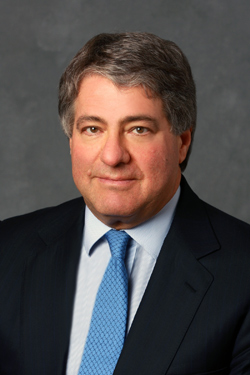
- About
- Departments & Services
- Projects
- Construction in Progress
- Service Requests
- News & Communications
Back to Top Nav
Back to Top Nav
Back to Top Nav
Dartmouth will officially dedicate the new Black Family Visual Arts Center, named in honor of former trustee Leon Black ’73 and his wife, Debra, on September 14. The institution will also celebrate the couple’s gift of a commissioned Ellsworth Kelly sculpture, Dartmouth Panels, which was installed in July on the east façade of the Hopkins Center for the Arts, facing the new Visual Arts Center. The event begins at 4:30 p.m. and is open to the public.

Former Dartmouth trustee Leon Black ’73 says he hopes the new Black Family Visual Arts Center “fosters creativity among Dartmouth’s students and faculty.” (photo courtesy of Apollo Management, LP)
“The much-anticipated opening of the Black Family Visual Arts Center signifies a historic moment for Dartmouth,” says President Carol L. Folt. “This magnificent building lets us offer all our students and faculty a host of exciting new opportunities to invigorate their learning and teaching. Through Leon and Debra Black’s extraordinary generosity, Dartmouth’s national leadership in the arts and in liberal arts education will continue to flourish.”
The Blacks, longtime patrons of the arts and leading art collectors who have supported many Dartmouth initiatives, contributed $48 million toward the visual arts center. Designed by Machado and Silvetti Associates, the 105,000-square-foot building anchors Dartmouth’s Arts District, which includes the Hopkins Center for the Arts and the Hood Museum of Art.
“We hope this building fosters creativity among Dartmouth’s students and faculty— that it inspires them to dream big, be courageous, take artistic risks—and infuses them with the life-changing power of the visual arts,” says Black, the founder, chairman, and CEO of Apollo Global Management, L.P.
The dedication will be held outdoors in the Maffei Arts Plaza, which connects the Black Family Visual Arts Center to the Hop and the Hood, and serves as a gateway from downtown Hanover to Dartmouth. The plaza, which features a formal lawn and sculpture terrace, was a gift of Sharon and Greg Maffei ’82.
At 5:30 p.m., the celebration will move indoors for faculty-led tours of the sustainably-designed building and a reception in the Nearburg Arts Forum and Nearburg Gallery. These spaces were a gift of Charles Nearburg ’72, Thayer ’74, in memory of his late son, Rett, who was an aspiring artist. An invitational exhibition of artwork by 14 distinguished alumni artists will be on display in the Nearburg Gallery and in the Top of the Hop.
The Black Family Visual Arts Center houses the departments of studio art, film and media studies, and digital humanities, promoting the cross-disciplinary interaction that is a hallmark of Dartmouth. Chair of the Studio Art Department Colleen Randall says, “Uniting all six areas of our department (architecture, drawing, painting, photography, printmaking, and sculpture) under the same roof will have a significant impact on our teaching and possibilities for collaboration between studio art faculty members. Also, being housed in the same building with film and media studies and digital humanities will increase the opportunities for multidisciplinary collaboration. We are looking forward to taking advantage of this technologically advanced facility, and its strategic location in Dartmouth’s Arts District, to connect the visual arts with the other humanities and the science departments in shaping and preparing our students to assume their future roles as artists and cultural leaders.”
Amy Lawrence, chair of the Department of Film and Media Studies, says, “The Black Family Visual Arts Center makes it possible for all film and media studies courses, students, and faculty to come together in one building for the first time in over a decade. Previously, we were dispersed across campus in three different buildings. This will make it possible for students to interact with each other as well as with studio art students.”
Lawrence adds that the faculty is looking forward to teaching classes in the visual arts center's 40-seat screening room, which, like the building's 243-seat Loew Auditorium, has state-of-the-art film projection equipment (16 millimeter and 35 millimeter, Blu-ray, and digital cinema projection). The new Stern Family Film and Media Seminar Room will also provide a gathering space for faculty and students, and a place for student collaboration and departmental functions. This room was a gift of Michael Stern ’59, Tuck ’60 and his wife, Marjorie; son Mark Stern ’85 and his wife, Betsy Burnham Stern ’84; and Ricki Stern ’87 and her husband, Evan Guillemin.
Randall notes that studio art faculty members are excited about their new teaching spaces. “The studios have a beautiful natural light along with a lighting system that enables us to program and preset different lighting configurations and zones,” she says. “And two important new spaces, the digital lab and the student gallery, will be shared spaces between studio art, film and media studies, and digital humanities. The digital lab will provide students with the most technically advanced digital tools for creating their own work, while the beautiful new student gallery will provide students with a space of their own to exhibit their work. It’s an amazing building!”
The Year of the Arts is a celebration of the excellence of the arts at Dartmouth. Major initiatives this year include the opening of the Black Family Visual Arts Center, the 50th anniversary of the Hopkins Center for the Arts, as well as a yearlong series of interdisciplinary academic programs that explore the intersections between the arts and other disciplines.
Dartmouth has long been a leader in integrating arts into the collegiate experience: from the establishment of one of the nation’s first campus-based performing arts centers, to the commissioning of new works and artist-in-residence programs. The diverse series of arts programs and initiatives this year exemplify Dartmouth’s historic commitment and role as a model for the artistic campus of the 21st century. For more information, please visit arts.dartmouth.edu